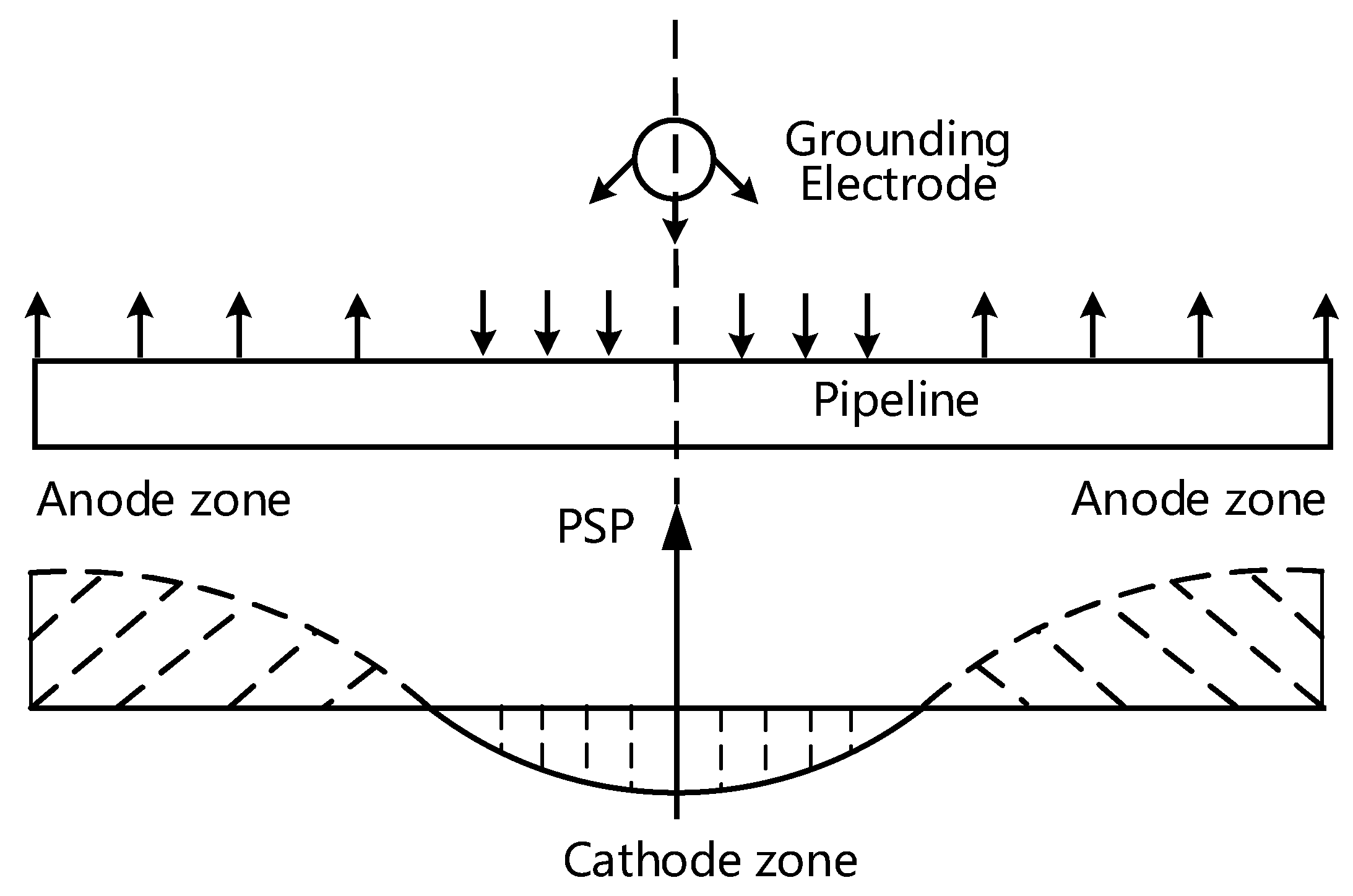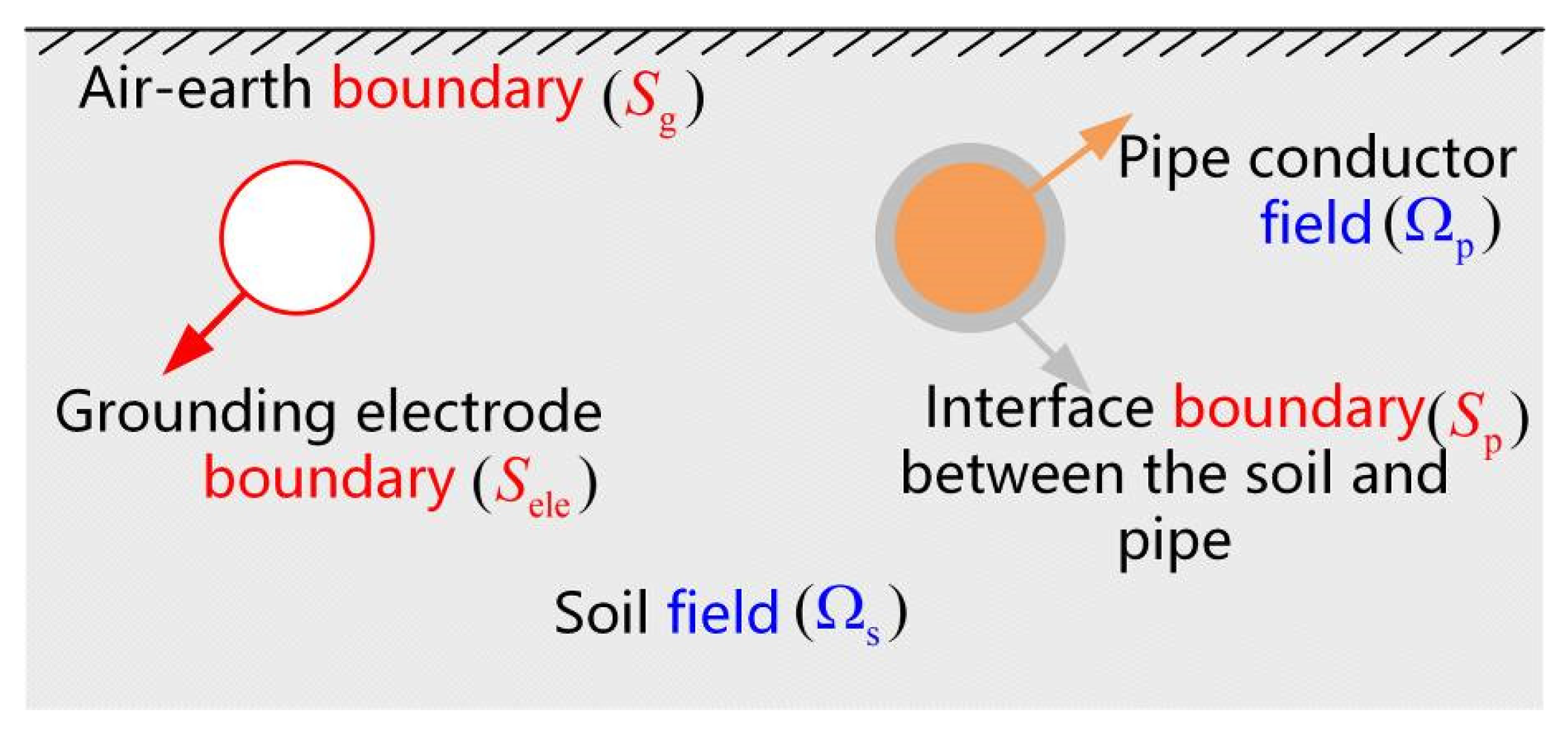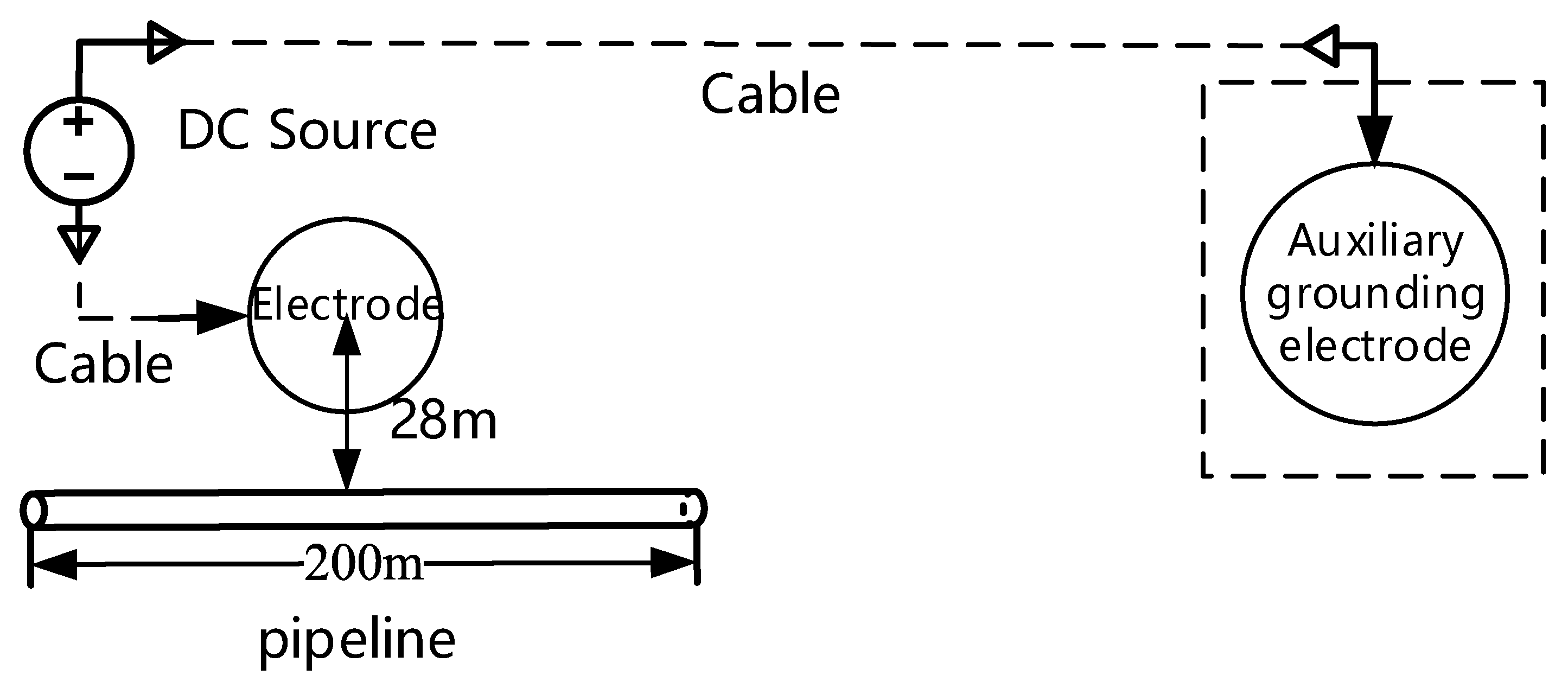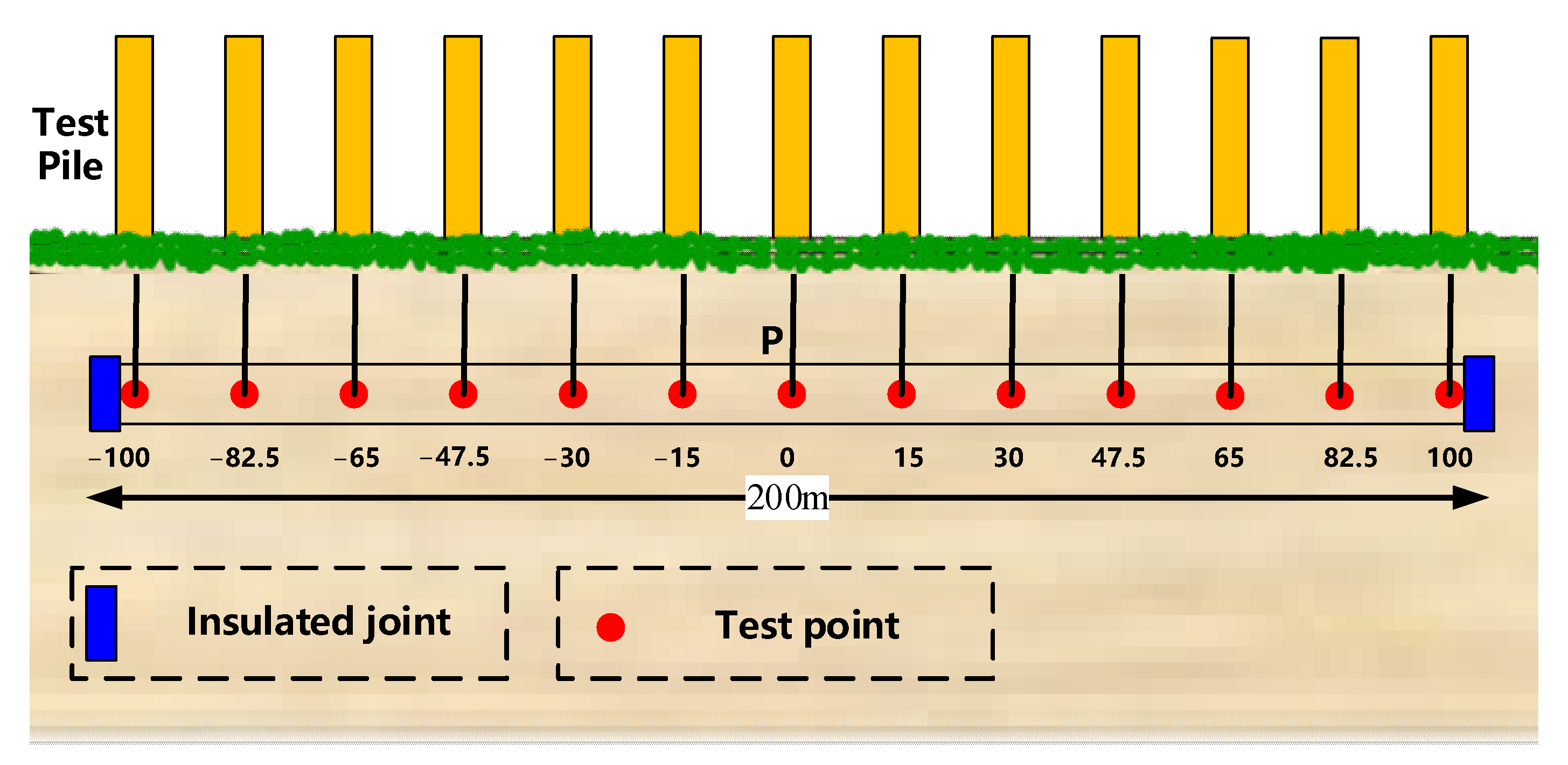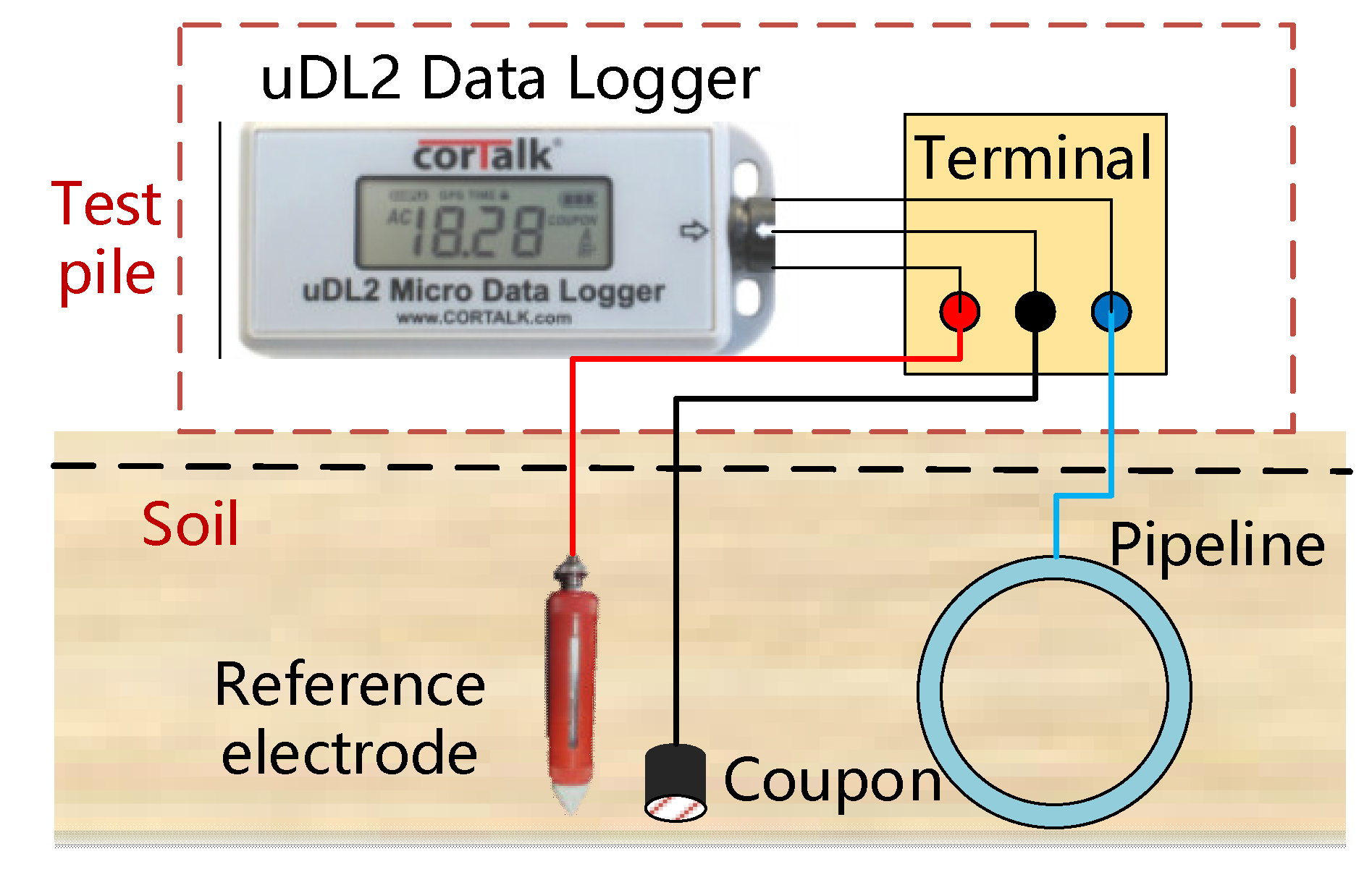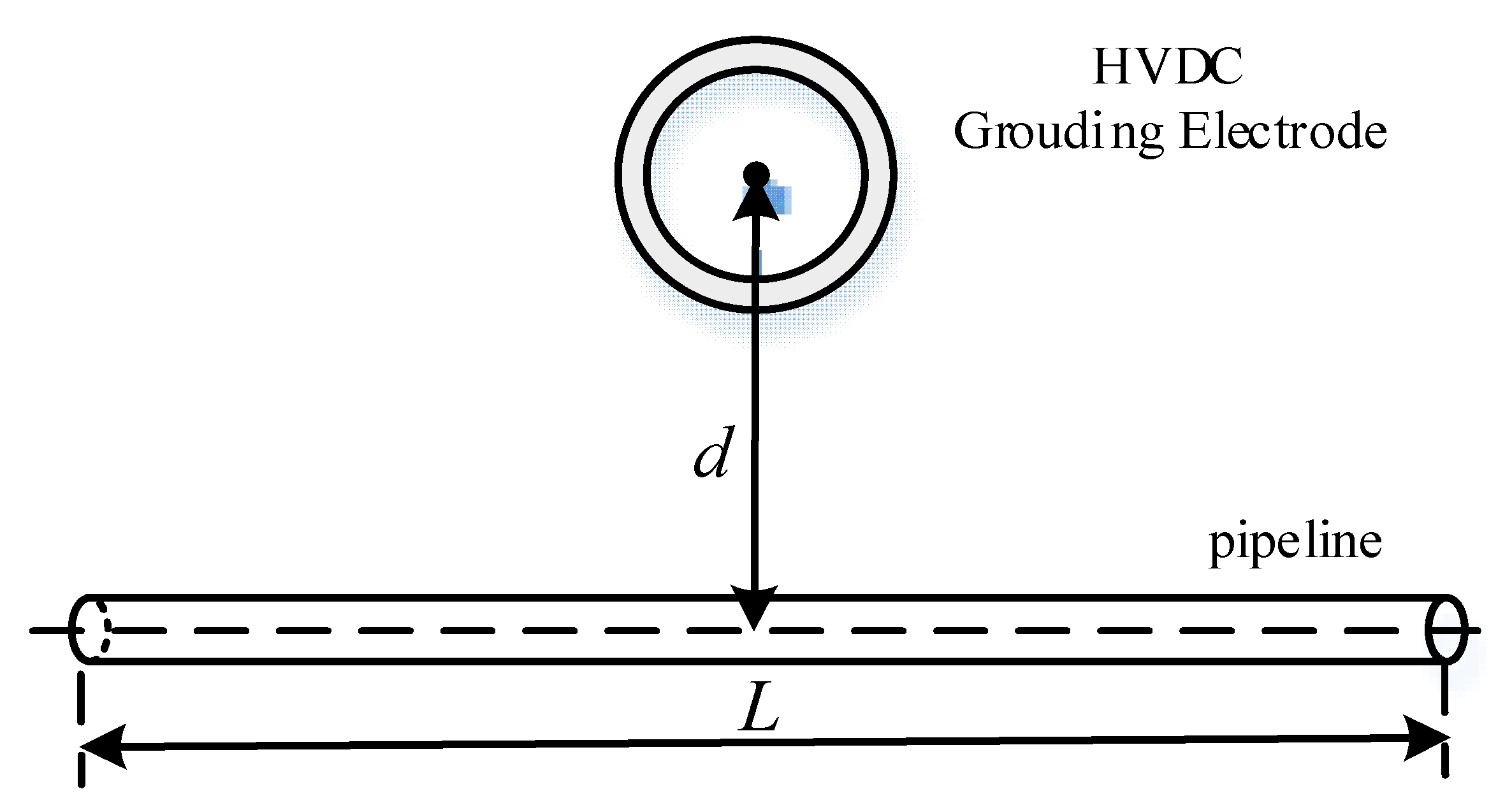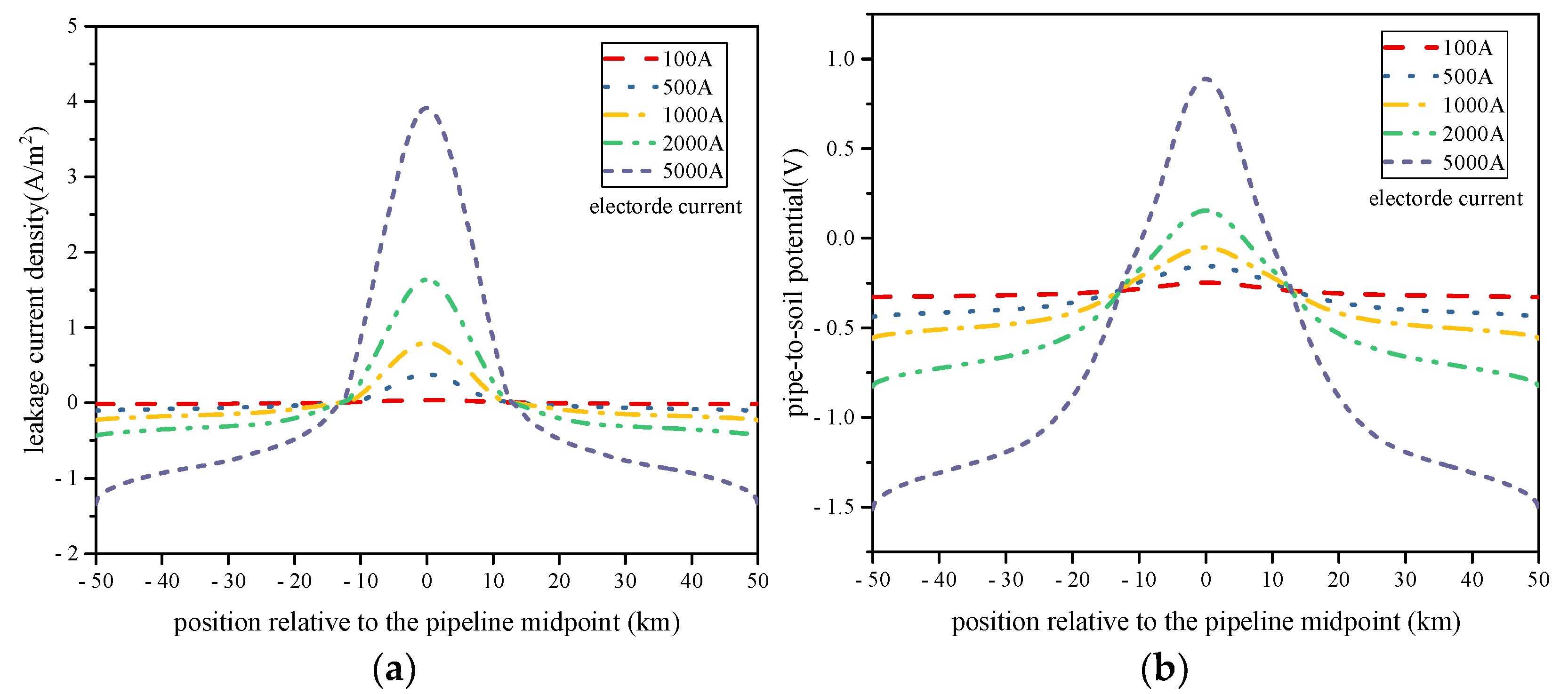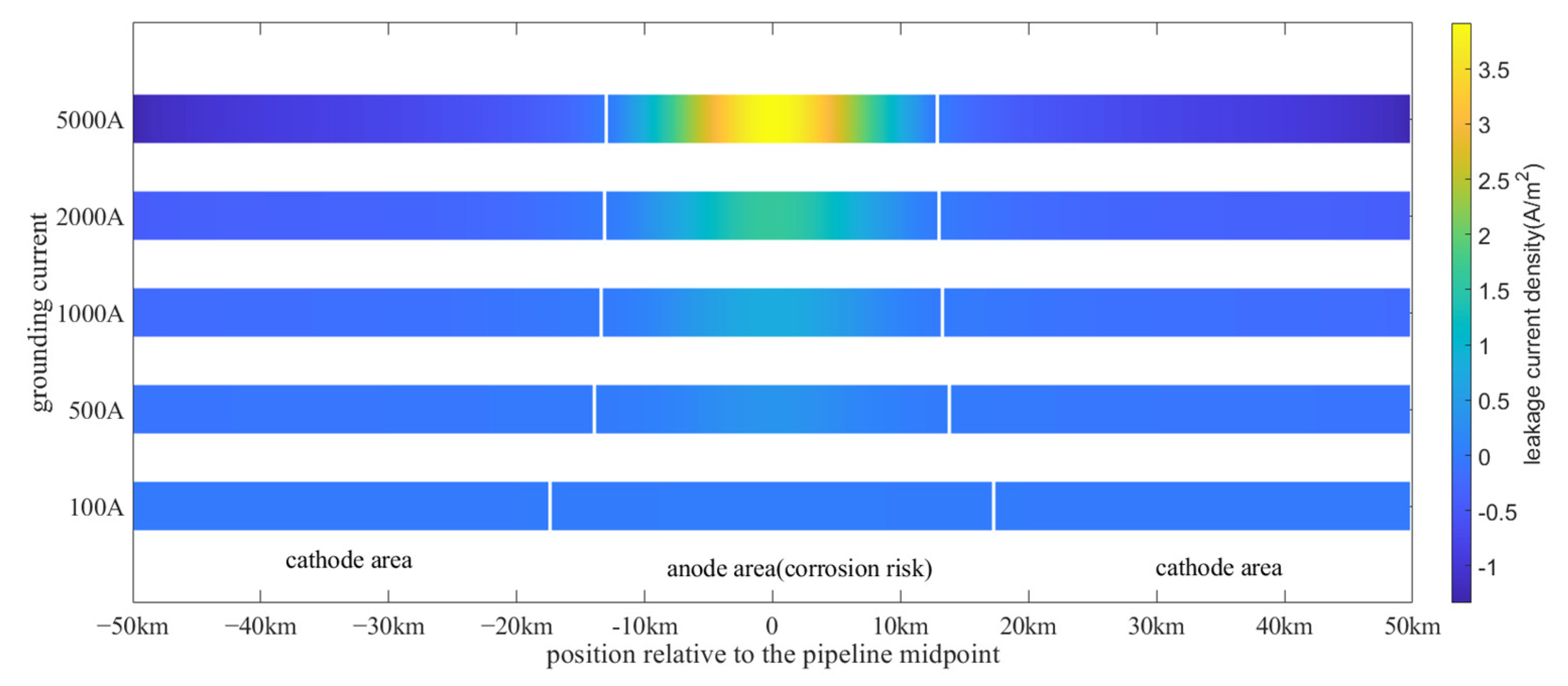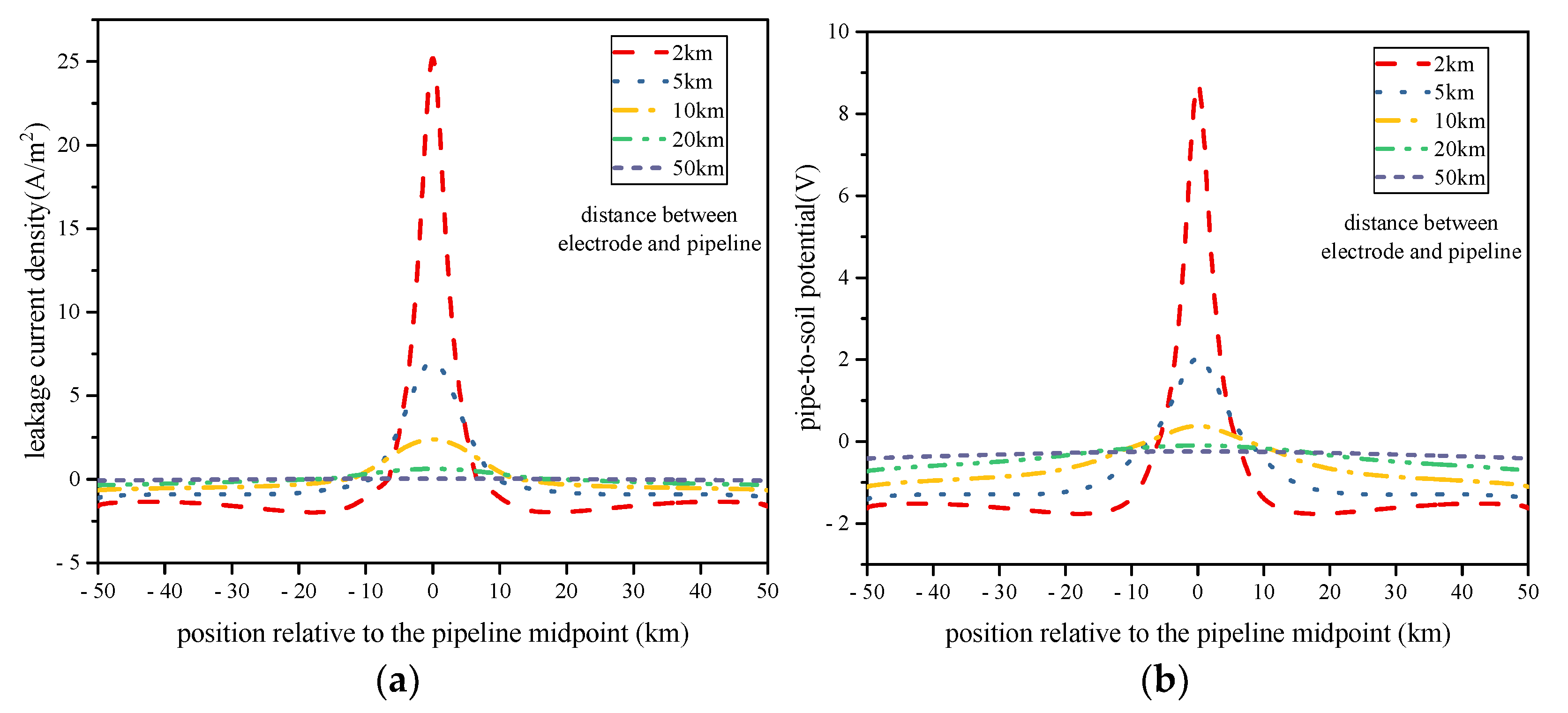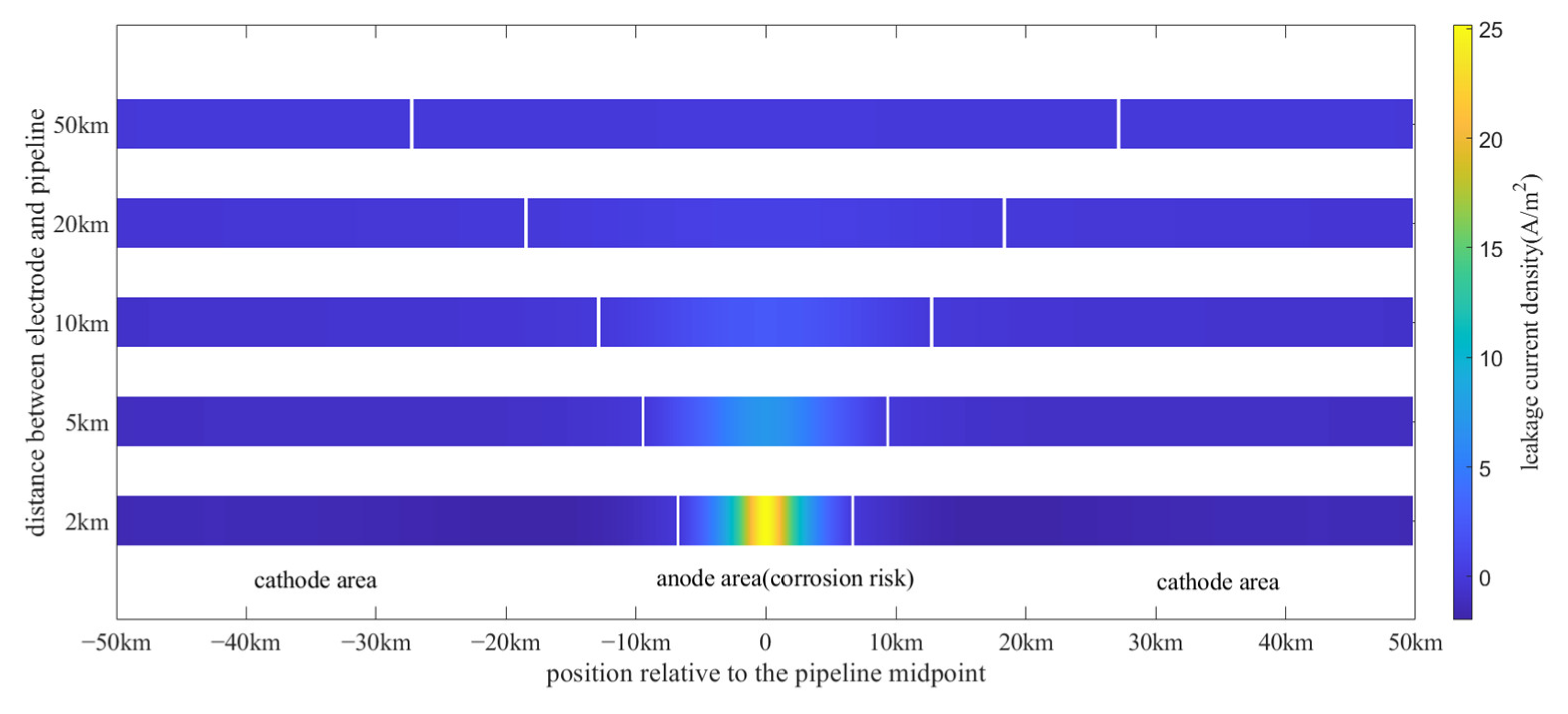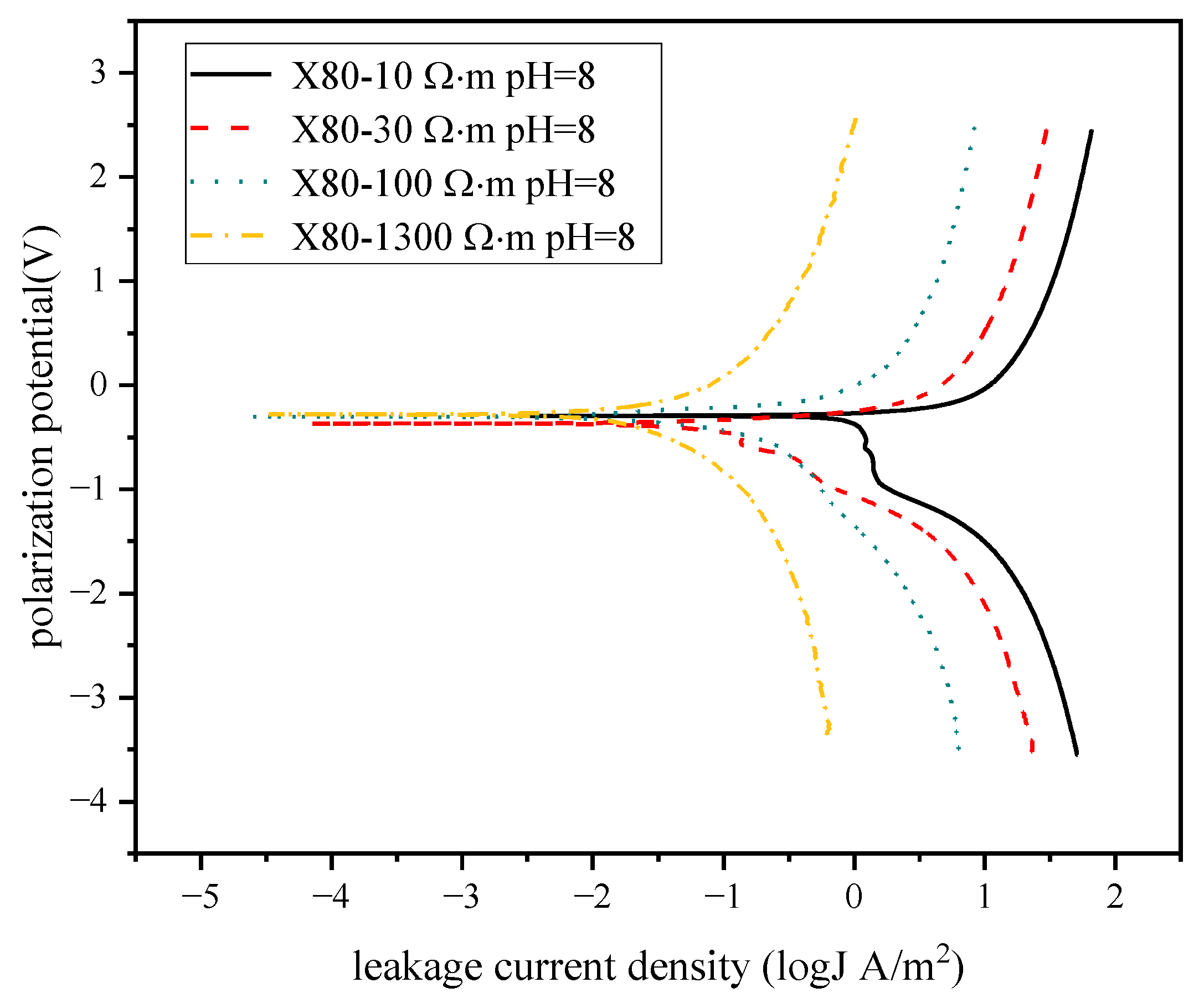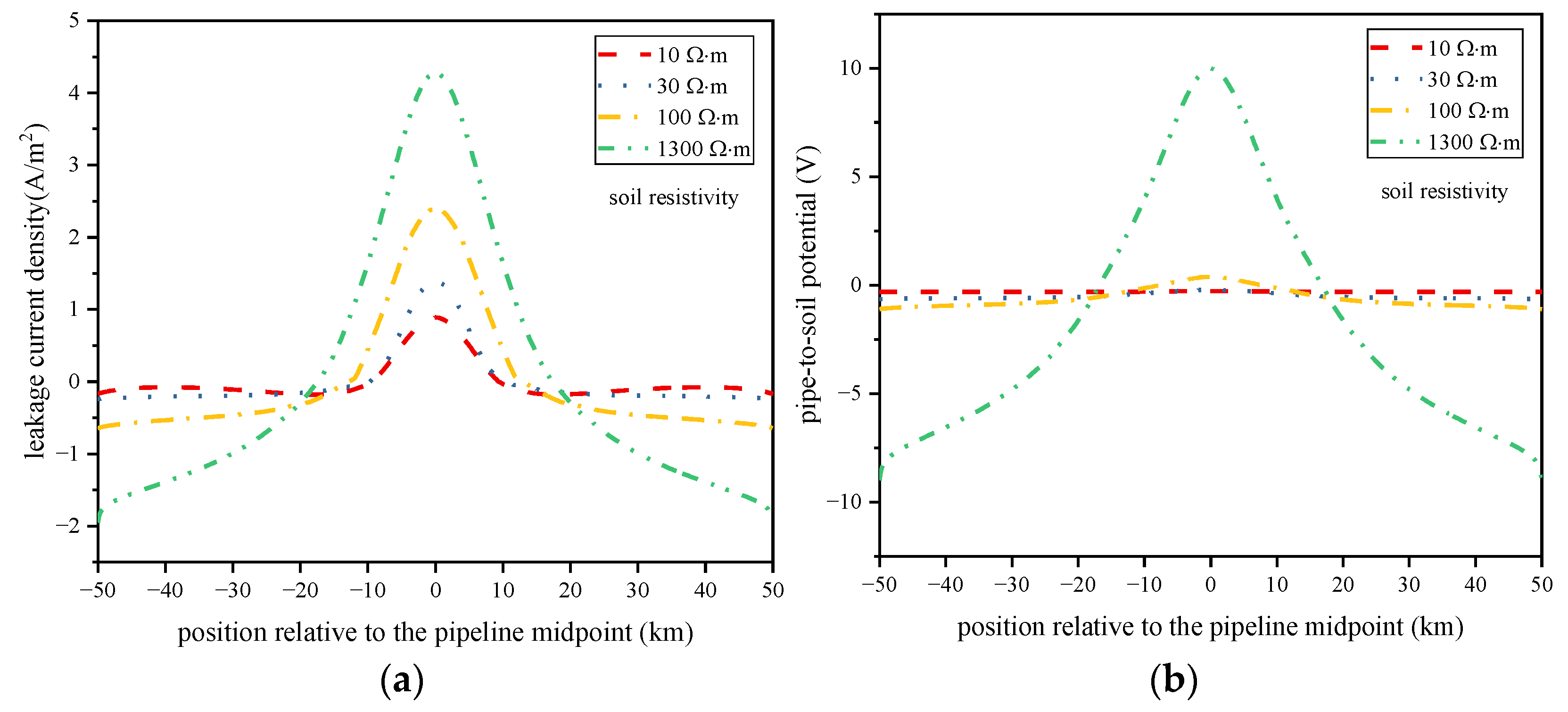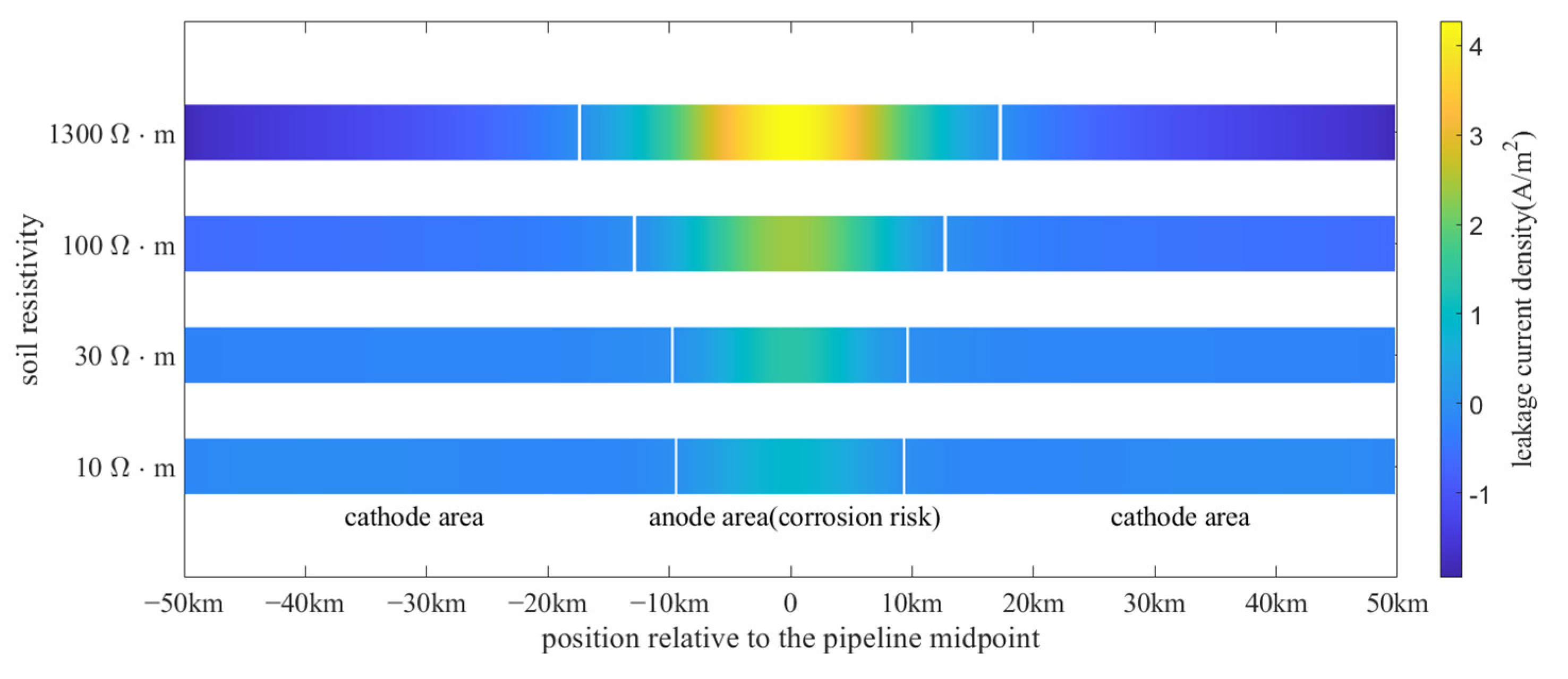1. Introduction
High voltage direct current (HVDC) transmission technology has been widely used in the power system for its advantages in large transmission capacity and long transmission distance. The grounding electrode current can reach several kilo-amperes when the HVDC transmission project is under monopole operation [
1]. This current may cause severe interference with buried pipelines in the vicinity of the electrode [
2,
3,
4]. The currents can flow into the pipeline at one point and flow out at another point. Metal corrosion can occur at the current-in point, while hydrogen embrittlement may occur at the current-out point, which both threaten the operation safety of pipeline engineering [
5,
6]. Therefore, it is very important to determine the interference characteristics of the electrode current with buried pipelines for pipeline risk assessment and safety protection.
In pipeline engineering, pipe-to-soil potential (PSP) and leakage current density are often used to indicate the DC interference degree [
7]. In the past, numerous tests were needed to obtain these two indicators along the pipelines [
8,
9]. In situ measurement is often costly and time-consuming so simulations represent an interesting option for the study of such phenomena. Many calculation methods have been proposed to determine the interference under different conditions. Lagace et al. used the transmission line model to simulate long pipelines by applying the pipeline conductor parameters and coating parameters to the transmission line equations [
10]. Yu et al. extended the simulation methodology by adding a local damage equivalent branch and cathodic protection branch for more practical engineering applications [
11]. Giao et al. first calculated the current distribution of the HVDC grounding electrode by the method of moments (MoM) [
12]. Then Dawalibi et al. developed the multi-step method to calculate the interaction of the multi-electrodes based on MoM [
13,
14]. Zhang et al. proposed a field-circuit coupling model to consider the impacts of different protective measures [
15]. However, the above-mentioned numerical methods cannot consider the nonlinear electrochemical polarization effectively, which may lead to inaccurate results for density and PSP calculations [
16]. The PSP deviates from the equilibrium potential when polarization occurs. This deviation becomes greater as the leakage current density increases. Besides, the polarization relationship is nonlinear and it can result in improper protective measures for pipeline safety.
There are many parameters that can influence the calculation results, such as the electrode grounding current, soil resistivity, soil structures, pipeline coating characteristics, and the distance between the electrode and pipeline. Differences in these parameters can lead to different pipeline safety assessments and protective measures. Therefore, it is necessary to study the interference distribution characteristics under the various above-mentioned parameters.
In this paper, a methodology based on a combination of MoM and FEM is proposed to calculate the pipeline interference caused by HVDC electrode current. The proposed method takes into account the pipe-soil interface polarization by introducing a nonlinear boundary condition which is difficult to consider for traditional methods. Then the interference distribution characteristics under different parameters are studied using the proposed method. These characteristics can be used to develop guidelines for practical engineering.
2. Interference Mechanism of the Grounding Current
The high-voltage DC grounding electrode is a grounding facility that provides a low resistance path during the operation of the HVDC transmission system [
17].
Figure 1 shows the interference process of the DC grounding electrode current on the buried metallic pipelines. The earth currents flow into the pipeline in the area close to the grounding electrode when the electrode is under anode operation. The currents flow out of the pipeline at the two ends which are far away from the electrode. As we can see, electrochemical corrosion occurs in the area currents flow out. The pipe-soil potential also has an obvious positive shift.
Different electrochemical reactions occur for different interference areas [
18]. The electrochemical reaction for the anode interference area is usually described by:
For the cathode interference area, hydrogen evolution reaction or oxygen absorption reactions dominate under different soil medium environments. In general, it can be shown as follows:
The above electrochemical reactions can finally lead to a specific relationship between the PSP and the leakage current which can be defined as follows:
where
J,
φp and
φs are the leakage current density, the pipe-side potential and the soil-side potential interface between the soil and pipe, respectively. The nonlinear function
fp, which describes the relationship between the pipe-to-soil potential and the leakage current density, can be measured by experiment. The three-electrode system is often used to measure the polarization curves with the potential sweep method [
19].
Figure 2 shows the typical three-electrode system for measuring polarization curves.
The discrete measurement data can be fitted by the Butler-Volmer equation which is one of the most fundamental equations in electrochemical kinetics. Equation (2) shows the typical Butler-Volmer equation [
20]:
where
J and
E are current density and PSP, respectively, and are obtained by measurement.
are the metal self-corrosion potential, self-corrosion current density, Tafel slope of the anode reaction and Tafel slope of the cathode reaction, respectively. The four parameters to be fitted can be obtained using the least square method. Then, the fitted functions can be used in the proposed methodology. The methodology must consider the nonlinear polarization to calculate the current and potential distribution accurately.
3. Mathematical Model Combining MoM with FEM
Pipeline corrosion is mainly caused by the resistive coupling of the grounding currents on the pipeline metal. The computation domain includes the soil area, the pipeline conductor area, as well as the infinite air-earth boundary, the grounding conductor boundary, and the interface boundary between the soil area and the pipeline conductor area.
Figure 3 shows the boundary value problem of the resistive coupling model between the grounding electrode and pipelines.
The conductivities are assumed to be homogeneous. Then, the soil field Ω
s and pipe conductor field Ω
p belong to the constant current field so the potential satisfies Laplace’s equations. The air can be considered as electrical insulating medium so the current flowing out of the air-earth boundary (
Sg) is zero. The total leakage current of the grounding electrode should equal the injected current in the HVDC transmission system based on the charge conservation law. According to the interface conditions for electric field vectors, the current density on the soil side should equal the current density on the pipe conductor side. Besides, the leakage current density also should satisfy the polarization relationship with the pipe-to-soil potential (
). The theoretical equations for the above three-dimensional boundary value problem can be formulated as follows:
where
is an arbitrary coordinate in the computation domain,
Ihvdc is the grounding current of the HVDC grounding electrode, and
and
are the conductivity of the pipe conductor and soil medium, respectively. A numerical method combining MoM and FEM is proposed to solve the above equations. The Laplace equation in the soil area is discretized by MoM which is suitable for open-domain problems. The Laplace equation in pipe conductor area is discretized by FEM which is suitable for enclosure domain problems. By applying the nonlinear polarization boundary conditions between the two areas, the two methods can be coupled for solving.
The potential of an arbitrary point in the soil area can be expressed as follows:
where
is the current source coordinate in the soil area,
is the leakage current density for the buried conductor, and
is the Green’s function for the above boundary problem. The electrode conductor and pipe conductor are divided into
M and
N segments, respectively. The basis function for different segment current density can be expressed as follows:
where
is the definitional domain of the buried conductors so
can be expressed as follows:
are the current density of the electrode conductor segments.
are the current density of the pipe conductor segments. Based on the MoM and point match method the following algebraic equation set can be formed.
The electrode is considered as an equipotential . The pipe potential on the soil side is .
Using the finite element Galerkin method for the pipe conductor area, another equation set can be formed as follows:
K is the Stiffness matrix element for different nodes.
are the pipe potential on the pipe side.
are the non-boundary node potentialin the pipe conductor area.
are the load elements which depend on the nonlinear polarization function. According to charge conservation, the electrode segment currents obey the following equation:
By combining Equations (7)–(9), the distribution of the PSP and leakage current along the pipeline can be solved with the Newton–Raphson Method.
5. Interference Distribution Characteristics
Based on the proposed calculation model, the interference distribution characteristics were analyzed under different parameters. These parameters include the electrode currents, soil resistivity, and the distance between the electrode and pipelines. Considering the following typical interference model, the length of the pipeline is
L, and the distance between the electrode and pipeline is
d. The soil is considered as a homogeneous medium and the soil resistivity is
r, pH = 8. The pipe material was X80 steel. A schematic diagram of the pipeline and HVDC grounding electrode arrangement is shown in
Figure 9.
5.1. Electrode Current
The relationship between the polarization potential and current density is the same as in
Section 5.1 and shown in
Figure 7. The other parameters are listed in
Table 1.
The distribution of the leakage current density and pip-to-soil potential under different HVDC ground currents are shown in
Figure 10.
As can be seen in
Figure 10, the leakage current density and PSP reach 3.92 A/m
2 and 0.89 V, respectively, when the grounding current is 5000 A. Both maximum leakage current density and maximum PSP increase as the electrode grounding current increases. Regression analysis shows that the relationship between the maximum leakage current density
Jmax and the electrode grounding current
Ihvdc is linear, that is
Jmax =
a1·Ihvdc +
b1 where
a1 and
b1 are fitting constant coefficients.
The maximum value is located at the midpoint of the pipeline. When currents flow out of the pipe, the pipeline faces corrosion risk, especially for the central area of the pipeline.
Figure 11 shows the corrosion risk area distribution under different grounding currents.
The length of anode area is 34.5 km under 100 A, whereas the length of anode area is 25.7 km under a 5000 A grounding current The result shows that the length facing corrosion risk decreases as the HVDC grounding current increases, which means the corrosion area is becoming more concentrated. The effect of grounding current on the anode area range is not very significant when the current exceeds 1000 A.
5.2. Distance between Electrode and Pipelines
The interference scope of the HVDC grounding current can reach tens of kilometers. Therefore, the potential and density distribution characteristics were studied in the range from 2 km to 50 km. A schematic diagram for the pipeline and HVDC grounding electrode arrangement is shown in
Figure 9. Five distance types (2 km, 5 km, 10 km, 20 km, 50 km) were chosen for study. The HVDC grounding current is 3000 A. The other parameters are the same as those listed in
Table 1. The relationship between polarization potential and current density is the same as in
Section 5.1 and shown in
Figure 7.
The results are shown in
Figure 12 for different distances between the electrode and pipelines.
The maximum leakage current density and PSP reach 25.2 A/m2 and 8.74 V, respectively, when the distance between electrode and pipeline is 2 km. As the distance increases, the maximum current density and PSP decrease gradually. Regression analysis shows that the relationship between the maximum leakage current density Jmax and the distance d satisfy negative exponential function, that is (b2 < 0) where a2 and b2 are fitting constant coefficients. That means that the interference current density increases as power function when the distance between electrode and pipeline decreases.
Figure 13 shows the interference range for the anode area and cathode area along the pipeline for different distances between the electrode and pipeline.
The distance between the electrode and pipeline has a significant influence on the anode area range. The anode area range increases as the distance increases. Although the anode area range extends, the influence degree decreases substantially.
5.3. Soil Resistivity
Soil resistivity influences not only the grounding current flow path but also the polarization. Four soil resistivity types (10, 30, 100, 1300 Ω·m) were chosen for study. The HVDC grounding current is 3000 A. The other parameters are the same as those listed in
Table 1. The polarization curves were measured under different soil conditions.
Figure 14 shows the test polarization curve data.
The calculation results of leakage current density and PSP are shown in
Figure 15.
The maximum leakage current density and PSP increase as the soil resistivity increases. Regression analysis shows that the relationship between the maximum leakage current density Jmax and the soil resistivity ρs satisfy logarithmic function, that is . a3 and b3 are fitting constant coefficients.
Figure 16 shows the interference range for the anode area and cathode area along the pipeline for different distances between the electrode and pipeline.
The results indicate that the anode area range extends as the soil resistivity becomes higher. Both the maximum leakage current density and corrosion risk area are positively correlated with the soil resistivity. Therefore, it is very important to evaluate the interference level accurately when dealing with highly resistive soil conditions.
